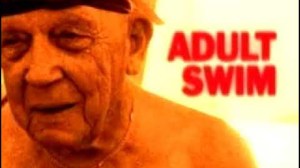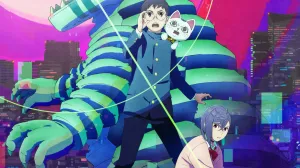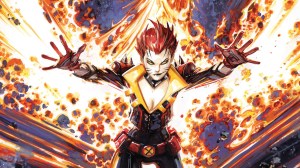A new episode of Star Trek: Picard debuted today on CBS All Access, bringing with it new Easter eggs and references to Star Trek: The Next Generation and other corners of the Star Trek universe. Here we’ve gathered up those nods with some background information about what they mean and where they come from. Keep reading to see what we noticed and why it matters.
Videos by ComicBook.com
The second episode of Star Trek: Picard is titled “The End is the Beginning.” It’s the third episode directed by Hannelle M. Culpepper.
Are you excited to see more Star Trek Easter eggs in Star Trek: Picard? Let us know in the comments.
New episodes of Star Trek: Picard become available to stream Thursdays on CBS All Access.
Disclaimer: ComicBook.com is owned by ViacomCBS.
Starfleet Uniforms
The opening flashback of the episode gives us a look at the Starfleet uniforms circa 2385. That’s the year of the attack on Mars.
Starfleet abandoned the grey shoulders that debuted with the Star Trek: The Next Generation movies. Instead, it went back to having division colors on the shoulders, similar to the uniforms in Star Trek: Deep Space Nine and Star Trek: Voyager, but with more intricate patterns.
The Beta Quadrant

The Star Trek galaxy is divided into four quadrants: Alpha, Beta, Delta, and Gamme. The flashback scene in this episode mentions the Beta Quadrant.
The Beta Quadrant is where the Klingon homeworld of Qo’noS is located. The Klingon Empire controls much of the territory in the quadrant, as does the Romulan Star Empire.
Vasquez Rocks
This location was featured in last week’s episode, but today’s episode confirms it is what it appears to be. Raffi’s home is located at Vasquez Rocks, a park in California. Star Trek has filmed many scenes at Vasquez Rocks, using it as a landscape for alien planets, but this is the first time it has appeared as itself in an episode of Star Trek.
The most notable episode to use Vasquez Rocks is the Star Trek: The Original Series episode “Arena.” The fight between Captain Kirk and the Gorn captain featured shots at the same jagged rock face that Raffi lives under.
Other episodes that used Vasquez Rocks as a location include The Original Series episodes “Shore Leave,” “The Alternative Factor, ” and “Friday’s Child,” the Next Generation episode “Who Watches the Watchers,” the Voyager episodes “Initiations” and “Gravity,” and the Enterprise episode “Unexpected.” The films Star Trek IV: The Voyage Home and 2009’s Star Trek both used Vasquez Rocks as the planet Vulcan, and Star Trek Into Darkness also filmed scenes there.
Hugh

This episode is the first to feature Hugh, played by Jonathan Del Arco. Del Arco first played Hugh in the Star Trek: The Next Generation episode “I, Borg.” He returned in the episode “Descent.”
In “I, Borg,” the Enterprise crew discovered a Borg drone. They took him on board the ship and freed him from the hive mind. The drone showed he was still capable of independent thought. The crew named him Hugh. It seems Hugh has better adjusted to life as a human these days and is helping free other Borg drones.
Kaseelian Opera
When Commodore Oh visits Dr. Jurati, Jurati is listening to music. The music is Kasseelian Opera.
It may sound familiar because it is the same kind of opera that Dr. Hugh Culber loves and that Paul Stamets tolerates because he loves Hugh in Star Trek: Discovery. Stamets listens to the same song that Jurati is listening to in the Discovery episode “Brother.” Jeff Russo scores both Discovery and Picard. He composed the
Romulan Assimilation

Hugh states in this episode that the disordered are the only Romulans he knows of that have ever been assimilated. That may be true for him, but Star Trek fans may remember that the Voyager crew encountered liberated Romulan ex-Borg in the Star Trek: Voyager episode “Unity.”
This also be a reference to the Star Trek: The Next Generation episode “The Neutral Zone.” It was the first Next Generation episode to feature the Romulans, and it revolved around mysterious attacks on Romulan outposts in the area. These attacks were intended to foreshadow the introduction of the Borg in subsequent episodes, but the writers strike the following year forced the show to change its plans.
EMH
When Picard boards Rios’s ship, he’s greeted by an EMH or Emergency Medical Hologram. These autonomous holograms are designed to fill-in on a ship who may have lost or been lacking a medical officer.
EMH’s were introduced in Star Trek: Voyager, with Robert Picardo playing one on the show. His EMH, referred to as The Doctor, gained sentience after his programming evolved from being left on for too long.
EMH’s in that era all looked the same, modeled after their creator. It seems EMHs in the time of Picard can be modeled to look like anyone.
The Q Continuum

Rios’ ENH lists several of Jean-Luc Picard’s accolades, beginning with him making first contact with the Q Continuum. This occurred in the very first episode of Star Trek: The Next Generation, “Encounter at Farpoint,” where the Enterprise was accosted by the omnipotent being called Q.
Q would return to pester Picard time and time again. He was last seen in The Next Generation‘s series finale, “All Goods Things.”
Klingon Arbirter
The ENH also mentions that Picard served as the arbiter of succession for the Klingon Empire. He was chosen for the role by the High Chancellor of the Klingon Empire, K’mpec, in the Next Generation episode “Reunion.”
Picard oversaw the choosing of a new High Chancellor. He finally bestowed the role on Gowron in the episode Redemption.
Borg Invasion

The ENH mentions that Picard defended Earth against Borg invasion. This may be a callback to “The Best of Both Worlds,” though Picard was working for the Borg as Locutus for most of that conflict.
It may also be a callback to the film Star Trek: First Contact. In that film, Picard and crew traveled back in time to the Borg from preventing the first contact between humans and Vulcans.
Spock
Finally, the ENH mentions that Picard worked with Spock. This is, of course, the iconic Vulcan played by Leonard Nimoy in Star Trek: The Original Series.
Nimoy reprised the role in an episode of Star Trek: The Next Generation. He and Picard worked together to try to reunify the Vulcan and Romulan peoples in the episode “Reunification.”
Types of Romulans

This episode addresses some inconsistencies in the appearances of Romulans throughout Star Trek history. In Star Trek: The Original Series, Romulans looked like Vulcans, which made sense as they have the same racial origin. Star Trek: The Next Generation reintroduced the Romulans and, as it did with the Klingons, added ridges to their foreheads. When Paramount Pictures rebooted the film series in 2009, that film included Romulans that did not have forehead ridges.
Picard has featured Romulans with ridges (Zhaban) and without ridges (Laris). Laris explains the distinction, noting that Romulans from the north have ridges (and a reputation for being stubborn) while other Romulans do not.
The Star Trek: The Next Generation Theme
We got hints of this in the last episode, but “The End is the Beginning” makes pointed use of the opening theme from Star Trek: The Next Generation (which was first used in Star Trek: The Motion Picture). The first hints of the theme pop up when Picard first beams aboard Rios’s ship. We can’t say for certain, but it may have been years since the last time Picard stepped aboard a starship. The notes play again as Picard passes by — and deliberately chooses not to sit in — the captain’s chair aboard the ship.
The big payoff comes at the end. We get the full opening of Star Trek: The Next Generation playing as the ship takes off into the stars, queued up by Picard speaking a familiar word…
Engage!

Is there a more perfect note to end the first act of Star Trek: Picard on? As his new crew boards Rios’s ship, everyone turns to Picard to await the command. He gives the words: “Engage.”
Engage is one of Picard’s signature phrases. He tended to use it when giving the command for the Enterprise to head out for its next destination.








